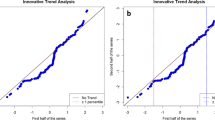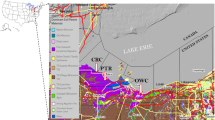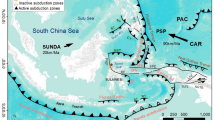Abstract
We applied multiple linear regressions to scrutinize the maximum variability produced in soil gas radon (Rn-222) by pressure, temperature and rainfall. Statistical methodologies were applied to discriminate the effect of pressure, temperature and rainfall for precise identification of seismic induced anomalies. High Rn-222 anomalies (HRA) as well as Low Rn-222 anomalies (LRA) were apparent. There were nine earthquakes (Mw ≥ 3) which were discernible to be manifested by preseismic soil gas Rn-222 anomalies. Correspondingly, observation centered on radon data set considering the precursory time ‘T’ (days), epicentral distance ‘D’ (km) and magnitude ‘M’ (Mw) has been derived as Log (DT) = 0.79 M + b. The discernible linear equation was found to be substantial with value of coefficient ‘b’ as 0.18 and approximately equal to those obtained by various investigators. In general coefficient ‘b’ is assigned as 0.15 for gaseous geo-seismic precursor. The value of coefficient ‘a ~ 3.51’, ‘b ~ 0.18’ and correction factor ‘K ~ 0.49 (kBqm-3 d)−1/2 were estimated empirically for the first time in Tezpur (Eastern Himalaya), India region. The calculated empirical value of ‘a’ by us gives another form of precursory manifestation zone (D) equation as D ~ 100.58 M. The values of coefficient ‘a’, ‘b’ and correction factor ‘K’ estimated for Tezpur, Assam (Eastern Himalaya) region perhaps can be used for probable earthquake forecast in the region constrained by the peak of the radon anomaly. The number of earthquakes registered was meager and further long-term analysis can estimate more precise and robust values of these parameters for soil gas Rn-222. The investigation also reassures us in a physical sense that seismic induced soil gas Rn-222 perturbation do exist in nature. The investigation is a probable approach for identification of seismic induced anomalies in soil gas Rn-222 and their characteristics for possible earthquake forecasting.









Similar content being viewed by others
References
Adams RD (1976) The Haicheng, China, earthquake of 4 February 1975; the first successfully predicted major earthquake. Earthq Eng Struct Dynam 4:423–437
Akinwande MO, Dikko HG, Samson A (2015) Variance inflation factor: as a condition for the inclusion of suppressor variable (s) in regression analysis. Open J Stat 5:754
Arora BR et al (2017) Assesment of the response of the meteorological/hydrological parameters on the soil gas radon emission at Hsinchu, northern Taiwan: a prerequisite to identify earthquake precursors. J Asian Earth Sci 149:49–63
Bakhmutov V, Groza A (2008) The dilatancy-diffusion model: new prospects. In: Proceedings, international conference: problems of geocosmos, 7th, St. Petersburg, Russia, May pp. 26–30
Baruah S et al (2020) Seismic vulnerability assessment of earthquake-prone mega-city Shillong, India using geophysical mapping and remote sensing. Georisk Assess Manag Risk Engin Syst Geohazards 14:112–127
Bhattacharya PM, Mukhopadhyay S, Majumdar R, Kayal J (2008) 3-D seismic structure of the northeast India region and its implications for local and regional tectonics. J Asian Earth Sci 33:25–41
Bhattacharya PM, Kayal J, Baruah S, Arefiev S (2010) Earthquake source zones in northeast India: seismic tomography, fractal dimension and b value mapping. In: Savage MK, Rhoades DA, Smith EGC, Gerstenberger MC, Vere-Jones D (eds) Seismogenesis and earthquake forecasting: The Frank Evison volume II. Springer, Berlin, pp 145–158
Bureau of Indian Standards (2002) Criteria for earthquake resistant design of structures. IS 1893 (Part 1)
Burman JP (1965) Moving seasonal adjustment of economic time series. J R Stat Soc Ser A (General) 128(4):534–558. https://doi.org/10.2307/2343468
Chetia T, Baruah S, Dey C, Sharma S, Baruah S (2019a) Probabilistic analysis of seismic data for earthquake forecast in North East India and its vicinity. Curr Sci 00113891:117
Chetia T, Baruah S, Dey C, Sharma S, Baruah S (2019b) Singular spectrum and principal component analysis of soil radon (Rn-222) emanation for better detection and correlation of seismic induced anomalies. Nonlinear Process Geophys Discuss. https://doi.org/10.5194/npg-2019-37
Chetia T, Sharma G, Dey C, Raju PL (2020a) Multi-Parametric approach for earthquake precursor detection in Assam valley (Eastern Himalaya, India) using satellite and ground observation data. Geotectonics 54:83–96
Chetia T, Baruah S, Baruah S, Dey C, Sharma S (2020b) Weibull distribution analysis of precursory time due apparent resistivity anomaly prior to earthquakes in the vicinity of multi-parametric geophysical observatory, Tezpur India. Geomat Nat Hazards Risk 11:1093–1114
Cicerone RD, Ebel JE, Britton J (2009) A systematic compilation of earthquake precursors. Tectonophysics 476:371–396. https://doi.org/10.1016/j.tecto.2009.06.008
Clements WE, Wilkening MH (1974) Atmospheric pressure effects on 222Rn transport across the earth-air interface. J Geophys Res 79:5025–5029. https://doi.org/10.1029/JC079i033p05025
Dickey DA, Fuller WA (1979) Distribution of the estimators for autoregressive time series with a unit root. J Am Stat Assoc 74:427–431. https://doi.org/10.1080/01621459.1979.10482531
Dobrovolsky I, Zubkov S, Miachkin V (1979) Estimation of the size of earthquake preparation zones. Pure Appl Geophys 117:1025–1044
Dobrovolsky I, Gershenzon NI, Gokhberg MB (1989) Theory of electrokinetic effects occurring at the final stage in the preparation of a tectonic earthquake. Phys Earth Planet Inter 57:144–156
Fisher RA (1921) Studies in crop variation. I. An examination of the yield of dressed grain from broadbalk. J Agric Sci 11:107–135. https://doi.org/10.1017/S0021859600003750
Fleischer RL (1981) Dislocation model for radon response to distant earthquakes. Geophys Res Lett 8:477–480
Friedmann H (1985) Anomalies in the radon content of spring water as earthquake precursor phenomena. EPR Earthq Prediction Res 3:179–189
Friedmann H (1991) Continuous spring water radon measurements in Austria and possible relations to earthquakes. In: International conference on earthquake prediction: state-of-the-art, Strasbourg pp. 15–18 October 1991 (preprints) pp. 233–240. https://pascal-francis.inist.fr/vibad/index.php?action=getRecordDetail&idt=4595632
Frost J (2014a) How to interpret a regression model with low R-squared and low P values. Retrieved on September, 12, 2018. https://blog.minitab.com/en/adventures-in-statistics-2/how-to-interpret-a-regression-model-with-low-r-squared-and-low-p-values
Frost J (2014b) Regression analysis: how to interpret S, the standard error of the regression. Minitab Blog vol. 23. https://blog.minitab.com/en/adventures-in-statistics-2/regression-analysis-how-to-interpret-s-the-standard-error-of-the-regression
Frost J (2017) Multicollinearity in regression analysis: problems, detection, and solutions. Statistics by Jim Available online also at: https://statisticsbyjimcom/regression/multicollinearity-in-regression-analysishttps://statisticsbyjim.com/regression/multicollinearity-in-regression-analysis[Accessed in Jakarta, Indonesia: December 22, 2018]. https://scholar.google.com/scholar?lookup=0&q=Frost+J+(2017)+Multicollinearity+in+regression+analysis:+problems,+detection,+and+solutions.+Statistics+by+Jim+Available+online+also+at:+https://statisticsbyjim+com/regression/multicollinearity-in-regression analysis/%5Baccessed+in+Jakarta,+Indonesia:+Decemb&hl=en&as_sdt=0,5
Galton F (1894) Natural inheritance. Macmillan and Company. https://scholar.google.com/scholar?cluster=3116647159146144760&hl=en&as_sdt=0,5
García C, García J, López Martín M, Salmerón R (2015) Collinearity: revisiting the variance inflation factor in ridge regression. J Appl Stat 42:648–661. https://doi.org/10.1080/02664763.2014.980789
Granger CW (1969) Investigating causal relations by econometric models and cross-spectral methods. Econometrica. 37:424–438
Granger CW (1988) Some recent developments in a concept of causality. J Econ 39:199–211
Granieri D, Chiodini G, Marzocchi W (2002) Continuous monitoring of Co2 soil diffuse degassing. In: volcanic sites: influence of environmental and volcanic parameters. The case of solfatara and ves uvius volcanoes (naples, Italy) EGSGA:2904. https://ui.adsabs.harvard.edu/abs/2002EGSGA..27.2904G/abstract
Gupta H (1988) Medium-term earthquake prediction. EOS Trans Am Geophys Union 69:1620–1630
Gupta HK (2001) Short-term earthquake forecasting may be feasible at Koyna, India. Tectonophysics 338:353–357
Gupta H, Singh H (1986) Seismicity of the North-East India region. II: earthquake swarms precursory to moderate magnitude to great earthquakes. J Geol Soc India 28:367–406
Gutenberg B (1956) The energy of earthquakes. Quarter J Geol Soc 112:1–14
Gutenberg B, Richter CF (1944) Frequency of earthquakes in California. Bull Seismol Soc Am 34:185–188
Hair JF, Anderson RE, Babin BJ, Black WC (2010) Multivariate data analysis: a global perspective (Vol. 7). Upper Saddle River, NJ: Pearson. https://pascal-francis.inist.fr/vibad/index.php?action=getRecordDetail&idt=8006600
Hartmann J, Levy JK (2005) Hydrogeological and gasgeochemical earthquake precursors–a review for application. Natural Hazards vol. 34:pp. 279–304. https://idp.springer.com/authorize/casa?redirect_uri=https://link.springer.com/content/pdf/https://doi.org/10.1007/s11069-004-2072-2.pdf&casa_token=0NhdPxZF_7EAAAAA:owBKiSW75nnc_3jUjmIP9HyRV8TZ5QVNvpswtTQBWLZuCgT4aHIAuEfUqLaqKNVGTX9ZgtYVAdxe1Zl1
Hatuda Z (1953) Radon content and its change in soil air near the ground surface. Memoirs of the College of Science, University of Kyoto. Series B, 20(4): pp. 285–306
Hauksson E, Goddard JG (1981) Radon earthquake precursor studies in Iceland. J Geophys Res Solid Earth 86:7037–7054
Hirata N (2004) Past, current and future of Japanese national program for earthquake prediction research. Earth Planet nd Space 56:xliii–l
Igarashi G, Wakita H (1990) Groundwater radon anomalies associated with earthquakes. Tectonophysics 180:237–254
Kayal J (2006) Shillong plateau earthquakes in northeast India region: complex tectonic model. Curr Sci 91:109–114
Kayal J (2008) Microearthquake seismology and seismotectonics of South Asia. Springer Science & Business Media, Berlin
Kayal J (2010) Himalayan tectonic model and the great earthquakes: an appraisal. Geomat Nat Haz Risk 1:51–67. https://doi.org/10.1080/19475701003625752
Kayal J et al (2012) Large and great earthquakes in the Shillong plateau–Assam valley area of Northeast India region: pop-up and transverse tectonics. Tectonophysics 532:186–192
Khattri K, Wyss M, Gaur V, Saha S, Bansal V (1983) Local seismic activity in the region of the Assam gap, northeast India. Bull Seismol Soc Am 73:459–469
King C-Y, Igarashi G (2002) Earthquake-related hydrologic and geochemical changes. International handbook of earthquake and engineering Seismology, Part A pp. 637–646. https://scholar.google.com/scholar?hl=en&as_sdt=0%2C5&q=King+C-Y%2C+Igarashi+G+%282002%29+Earthquake-related+hydrologic+and+geochemical+changes.+International+Handbook+of+Earthquake+and+Engineering+Seismology%2C+Part+A%3A637-646&btnG=
King CY, Zhang W, King B-S (1993) Radon anomalies on three kinds of faults in California. Pure Appl Geophys 141(1):111–124
Kraner HW, Schroeder GL, Lewis AR, Evans RD (1964) Large volume scintillation chamber for radon counting. Rev Sci Instrum 35:1259–1265. https://doi.org/10.1063/1.1718718
Kumar A, Singh S, Mahajan S, Bajwa BS, Kalia R, Dhar S (2009) Earthquake precursory studies in Kangra valley of North West Himalayas, India, with special emphasis on radon emission. Appl Radiat Isot 67:1904–1911. https://doi.org/10.1016/j.apradiso.2009.05.016
Kumar A, Walia V, Singh S, Bajwa BS, Dhar S, Yang TF (2013) Earthquake precursory studies at Amritsar Punjab, India using radon measurement techniques. Int J Phys Sci 7:5669–5677
Kumar A et al (2015) Identifications and removal of diurnal and semidiurnal variations in radon time series data of Hsinhua monitoring station in SW Taiwan using singular spectrum analysis. Nat Hazards 79:317–330. https://doi.org/10.1007/s11069-015-1844-1
Mansfield ER, Helms BP (1982) Detecting multicollinearity. Am Stat 36:158–160. https://doi.org/10.1080/00031305.1982.10482818
Martinelli G (2015) Hydrogeologic and geochemical precursors of earthquakes: an assessment for possible applications. Bollettino di Geofisica Teorica ed Appl 56:83–94
Martinelli G (1993) Fluidodynamical and chemical features of radon 222 related to total gases: implications foe earthquake predictions-proceedings of an advisory group meeting on isotopic and geochemical precursors of earthquakes and volcanic eruptions, Vienna, 1991, International Atomic Energy Agency pp. 48–62. https://inis.iaea.org/search/search.aspx?orig_q=RN:25017741
Merolla P, Mose D, King A (2003) Effect of water table fluctuations on radon emanation from soil. https://scholar.google.com/scholar?hl=en&as_sdt=0%2C5&q=Merolla+P%2C+Mose+D%2C+King+A+%282003%29+Effect+of+water+table+fluctuations+on+radon+emanation+from+soil.+&btnG=
Miklavčić I, Radolić V, Vuković B, Poje M, Varga M, Stanić D, Planinić J (2008) Radon anomaly in soil gas as an earthquake precursor. Appl Radiat Isot 66:1459–1466
Miles J (2014) Tolerance and variance inflation factor. Wiley StatsRef: Statistics Reference Online. https://onlinelibrary.wiley.com/doi/abs/https://doi.org/10.1002/9781118445112.stat06593
Monnin M, Seidel J (1992) Radon in soil-air and in groundwater related to major geophysical events: a survey. Nucl Instrum Methods Phys Res Sect A 314:316–330
Nandy D, Dasgupta S (1991) Seismotectonic domains of northeastern India and adjacent areas. Phys Chem Earth 18:371–384
Nandy D (2001) Geodynamics of northeastern India and the adjoining region. acb Publication Calcutta p. 209. https://scholar.google.com/scholar?hl=en&as_sdt=0%2C5&q=Nandy+D+%282001%29+Geodynamics+of+northeastern+India+and+the+adjoining+region.+acb+Publication+Calcutta%2C+209p.+&btnG=
Neri M, Ferrera E, Giammanco S, Currenti G, Cirrincione R, Patanè G, Zanon V (2016) Soil radon measurements as a potential tracer of tectonic and volcanic activity. Sci Rep 6:24581. https://doi.org/10.1038/srep24581
Ni J, Barazangi M (1984) Seismotectonics of the Himalayan collision zone: GEOMETRY of the underthrusting Indian plate beneath the Himalaya. J Geophy Res Solid Earth 89:1147–1163
Nielson K, Rogers V, Gee G (1984) Diffusion of radon through soils: a pore distribution model. Soil Sci Soc Am J 48:482–487. https://doi.org/10.2136/sssaj1984.03615995004800030002x
Oliveira S, Viveiros F, Silva C, Pacheco JE (2018) Automatic filtering of soil CO2 flux data; different statistical approaches applied to long time series. Front Earth Sci 6:208. https://doi.org/10.3389/feart.2018.00208
Pearl J (2009) Causal inference in statistics: an overview. Stat Surv 3:96–146
Pearl J (2010) Causal inference. Paper presented at the proceedings of workshop on causality: objectives and assessment at NIPS 2008, Proceedings of Machine Learning Research. https://proceedings.mlr.press/v6/pearl10a.html
Pham V, Geller RJ (2002) Comment on “Signature of pending earthquake from electromagnetic anomalies by K. Eftaxias et al. Geophys Res Lett. https://doi.org/10.1029/2002GL015328
Planinić J, Radolić V, Vuković B (2004) Radon as an earthquake precursor. Nucl Instrum Methods Phys Res Sect A 530:568–574
Raleigh B (1977) Prediction of Haicheng earthquake. Eos Trans Am Geophys Union 58:236–272
Reasenberg PA (1985) FPFIT, FPPLOT, and FPPAGE: Fortran computer programs for calculating and displaying earthquake fault-plane solutions. US Geol Surv Open-File Rep pp. 85–739. https://ci.nii.ac.jp/naid/10029016087/
Rikitake T (1979) Classification of earthquake precursors. Tectonophysics 54:293–309
Rikitake T, Hamada K (2003) Earthquake prediction. Encyclopedia of physical science and technology (Third Edition). https://www.sciencedirect.com/topics/computer-science/earthquake-prediction
Sano Y, Tominaga T, Nakamura Y, Wakita H (1982) 3He/4He ratios of methane-rich natural gases in Japan. Geochem J 16:237–245
Sharma AK, Walia V, Virk H (2000) Effect of meteorological parameters on radon emanation at Palampur (HP). J Assoc Explor Geophys 21:47–50
Silva C, Viveiros F, Ferreira T, Gaspar J, Allard P (2015) Diffuse soil emanations of radon and hazard implications at Furnas Volcano, São Miguel Island (Azores). Geol Soc London Mem 44:197–211. https://doi.org/10.1144/M44.15
Singh S, Sharma DK, Dhar S, Randhawa SS (2006) Geological significance of soil gas radon: a case study of Nurpur area, district Kangra, Himachal Pradesh, India. Radiat Meas 41:482–485
Singh S, Kumar A, Bajwa BS, Mahajan S, Kumar V, Dhar S (2010) Radon monitoring in soil gas and ground water for earthquake prediction studies in North West Himalayas, India. TAO Terr Atmos Ocean Sci 21:6
Tareen ADK, Nadeem MSA, Kearfott KJ, Abbas K, Khawaja MA, Rafique M (2019) Descriptive analysis and earthquake prediction using boxplot interpretation of soil radon time series data. Appl Radiat Isot 154:108861. https://doi.org/10.1016/j.apradiso.2019.108861
Thomas D (1988) Geochemical precursors to seismic activity. Pure Appl Geophys 126:241–266. https://doi.org/10.1007/BF00878998
Tomer A (2016) Radon as a earthquake precursor: a review. Int J Sci Eng Technol 4:815–822. https://doi.org/10.1140/epjst/e2015-02395-9
Toutain J-P, Baubron J-C (1999) Gas geochemistry and seismotectonics: a review. Tectonophysics 304:1–27. https://doi.org/10.1016/S0040-1951(98)00295-9
Ulomov VI, Mavashev BZ (1967) A precursor of a strong tectonic earthquake. Doklady Akademii Nauk Russian Acad Sci 176(2):319–321. http://www.mathnet.ru/php/archive.phtml?wshow=paper&jrnid=dan&paperid=33336&option_lang=eng
Ulomov VI (1971) Forerunners of the Tashkent earthquake. Izvestia Akadamiyi Nauk Uzbeckistan SSR:188–200
Verma M, Bansal BK (2012) Earthquake precursory studies in India: scenario and future perspectives. J Asian Earth Sci 54:1–8
Virk H, Singh B (1994) Radon recording of Uttarkashi earthquake. Geophys Res Lett 21:737–740
Viveiros F, Ferreira T, Vieira JC, Silva C, Gaspar J (2008) Environmental influences on soil CO2 degassing at Furnas and Fogo volcanoes (São Miguel Island, Azores archipelago). J Volcanol Geoth Res 177:883–893. https://doi.org/10.1016/j.jvolgeores.2008.07.005
Walia V, Virk H, Bajwa B, Sharma N (2003) Relationships between radon anomalies and seismic parameters in NW Himalaya, India. Radiat Meas 36:393–396. https://doi.org/10.1016/S1350-4487(03)00158-6
Walia V, Su T, Fu C, Yang T (2005) Spatial variations of radon and helium concentrations in soil-gas across the Shan-Chiao fault, Northern Taiwan. Radiat Meas 40:513–516
Walia V, Mahajan S, Kumar A, Singh S, Bajwa BS, Dhar S, Yang TF (2008) Fault delineation study using soil–gas method in the Dharamsala area, NW Himalayas, India. Radiat Meas 43:S337–S342
Wiemer S (2001) A software package to analyze seismicity: ZMAP. Seismol Res Lett 72:373–382
Wood FS (1984) Comment: effect of centering on collinearity and in+terpretation of the constant. Am Stat 38:88–90. https://doi.org/10.1080/00031305.1984.10483173
Acknowledgements
We convey our sincere acknowledgement to the Ministry of Earth Sciences (MoES) Government of India, New Delhi for the sponsorship vide sanction order no. MoES/P.O.(Seismo)/NPEP-16/2011. We thank Director, CSIR-NEIST Jorhat for giving necessary permission to publish this paper. We also convey our hearty thank you to reviewers and editors for their generous suggestion which has helped us a lot to improve the work manifold.
Author information
Authors and Affiliations
Corresponding author
Additional information
Publisher's Note
Springer Nature remains neutral with regard to jurisdictional claims in published maps and institutional affiliations.
Rights and permissions
About this article
Cite this article
Chetia, T., Baruah, S., Dey, C. et al. Seismic induced soil gas radon anomalies observed at multiparametric geophysical observatory, Tezpur (Eastern Himalaya), India: an appraisal of probable model for earthquake forecasting based on peak of radon anomalies. Nat Hazards 111, 3071–3098 (2022). https://doi.org/10.1007/s11069-021-05168-9
Received:
Accepted:
Published:
Issue Date:
DOI: https://doi.org/10.1007/s11069-021-05168-9




